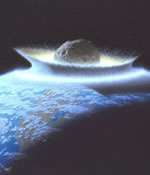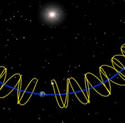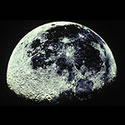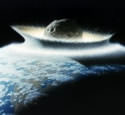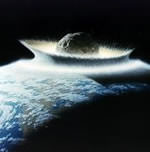
Image credit: NASA
Researchers have built a computer simulation that better predicts how large asteroids will interact with the Earth’s atmosphere. They found that more asteroids blow up in the atmosphere than previously thought, reducing the risk of them hitting populated areas or causing tidal waves. Their model says that an asteroid has to be 200 metres in diameter or above before it can get through the atmosphere, and these only hit the Earth once every 170,000 years.
Researchers from Imperial College London and the Russian Academy of Sciences have built a computer simulation that predicts whether asteroids with a diameter up to one kilometre (km) will explode in the atmosphere or hit the surface.
The results indicate that asteroids with a diameter greater than 200 metres (the length of two football pitches) will hit the surface approximately once every 160,000 years – way down on previous estimates of impacts every 2,500 years.
The findings also predict that many more asteroids blow up in the atmosphere than previous estimates, which means the hazard posed by impact-generated tidal waves or tsunamis is lower than previous predictions. The researchers suggest that proposals to extend monitoring of Near Earth Objects (NEO) to include much smaller objects should be reviewed.
Dr Phil Bland of Imperial’s Department of Earth Science and Engineering and a Royal Society University Research Fellow, said:
“There is overwhelming evidence that impacts from space have caused catastrophes for life on Earth in the past, and will do so again.
“On the Moon it’s easier to track the number, frequency and size of collisions because there is no atmosphere, so everything hits the surface. On Earth the atmosphere acts like a screen and geological activity erodes many craters too.
“Massive impacts of the type thought to have wiped out the dinosaurs leave an indelible print on the Earth but we have not been able to accurately document the effect of smaller impacts. Now, we have a handle on the size of ‘rock’ we really need to worry about and how well the Earth’s atmosphere protects us.”
When small asteroids hit the atmosphere the two forces collide like two objects smashing together, which often breaks the asteroid into fragments. Until now, scientists have relied on the ‘pancake’ model of asteroid impact to calculate whether the asteroid will explode in the atmosphere. This treats the cascade of fragments as a single continuous liquid that spreads out over a larger area – to form a ‘pancake’. But a new model known as the ‘separate fragment’ (SF) model, which was developed by co-author of the study, Dr Natalya Artemieva of the Russian Academy of Science, has challenged this approach.
“While the pancake model can accurately predict the height from the Earth’s surface at which the asteroid will break up, it doesn’t give an accurate picture of how the asteroid will impact,” explains Dr Bland. “The SF model tracks the individual forces acting on each fragment as it descends through the atmosphere.”
To create a more accurate model of how asteroids interact with the atmosphere the researchers ran more than 1,000 simulations using both models. Objects made of either iron or stone, known as ‘impactors’, were used to reflect the composition of asteroids and experiments were run with varying diameters up to 1 km.
The researchers found the number of impacts for iron impactors were comparable using both models. For stone the pancake model significantly overestimated the survivability rate across the range used.
The SF simulations also allowed the researchers to define the different styles of fragmentation and impact rates for iron and stone, which correspond closely with crater records and meteorite data.
“Our data show that over most of the size range we investigated stony asteroids need to be 1,000 times bigger than the iron ones to make a similar sized crater. Much larger objects are disrupted in the atmosphere than previously thought.
“But we are not out of the woods yet,” added Dr Bland “asteroids that fragment in the atmosphere still pose a significant threat to human life.”
Dr Phil Bland is a member of the Meteorite and Impact Group that includes scientists from Imperial College London and the Natural History Museum.
Original Source: Imperial College News Release

